Topic: Venom and venom fangs in snakes, lizards and synapsids
Although the evolution of snake fangs itself provides us with a window on convergence, the presence of fang-like teeth in lizards, therapsids and mammals provides an even broader and more remarkable perspective.
Toxic venom associated with some form of specialised dentition (e.g. fangs) has evolved a number of times within the reptiles, as well as in some mammal-like reptiles and even true mammals. The majority of reptiles possess a fairly simple dentition composed of peg-like teeth of similar shape and size throughout the jaw (termed ‘homodont’), but several groups of toxic reptiles have more specialised dentitions. Perhaps most famously, certain snakes (e.g. vipers and cobras) have a pair of enlarged, hollow venom fangs in the upper, maxillary jaw, and interestingly, vipers and cobras independently arrived at the same developmental mechanism for formation of their anterior fangs. Venom fangs evolved convergently outside the snakes, for example in anguiform lizards (e.g. Varanus, Heloderma), the Triassic archosaur Uatchitodon, Permian therapsid Euchambersia (a mammal-like reptile) and a few small mammals, including Solenodon and two groups of shrews. These examples are all discussed in more detail below:
Venom fangs in snakes
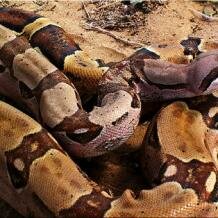 A system comprising venom glands in the upper and/or lower jaw with variably specialised teeth for venom delivery is proposed to have evolved once in the squamates, around 200Ma (the Triassic-Jurassic boundary), when snakes, iguanid and anguiform lizards diverged from non-venomous lizards groups such as skinks, amphisbaenians and teiids. Venomous snakes and lizards comprise an impressive 58% of squamate diversity, suggesting that this innovation may have been crucial to their subsequent ecological success. Within the snakes, the ancestral venom system evolved to include highly specialized venom fangs located in the upper jaw, with associated reduction of remaining dentition:
A system comprising venom glands in the upper and/or lower jaw with variably specialised teeth for venom delivery is proposed to have evolved once in the squamates, around 200Ma (the Triassic-Jurassic boundary), when snakes, iguanid and anguiform lizards diverged from non-venomous lizards groups such as skinks, amphisbaenians and teiids. Venomous snakes and lizards comprise an impressive 58% of squamate diversity, suggesting that this innovation may have been crucial to their subsequent ecological success. Within the snakes, the ancestral venom system evolved to include highly specialized venom fangs located in the upper jaw, with associated reduction of remaining dentition:
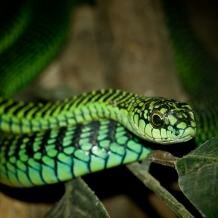 The most primitive snakes are called ‘Henophidia’ and belong to the family Boidae (pythons and boas), well known for being able to distend their jaws and bodies to consume very large prey. Tooth rows exist on the upper and lower jaws, termed maxillary and dentary bones respectively, and as a moveable inner tooth row on the upper jaw, composed of two bones called the palatine (anterior) and pterygoid (posterior). As is typical for reptiles, boid teeth are unspecialized, and all similar in shape and size (termed ‘homodont’ dentition). This non-venomous, non-specialised dentition was succeeded in more advanced snakes by reduction of tooth number and evolution of a post-orbital venom gland and associated paired venom fangs on the upper, maxillary jaw bone. These advanced snakes are termed the ‘Caenophidia’ and include three major groups (Viperidae, Elapidae and Colubridae) with slightly different fang morphologies, although each fang type is known to have evolved from a common ancestor and is clearly traceable to a shared developmental and genetic origin.
The most primitive snakes are called ‘Henophidia’ and belong to the family Boidae (pythons and boas), well known for being able to distend their jaws and bodies to consume very large prey. Tooth rows exist on the upper and lower jaws, termed maxillary and dentary bones respectively, and as a moveable inner tooth row on the upper jaw, composed of two bones called the palatine (anterior) and pterygoid (posterior). As is typical for reptiles, boid teeth are unspecialized, and all similar in shape and size (termed ‘homodont’ dentition). This non-venomous, non-specialised dentition was succeeded in more advanced snakes by reduction of tooth number and evolution of a post-orbital venom gland and associated paired venom fangs on the upper, maxillary jaw bone. These advanced snakes are termed the ‘Caenophidia’ and include three major groups (Viperidae, Elapidae and Colubridae) with slightly different fang morphologies, although each fang type is known to have evolved from a common ancestor and is clearly traceable to a shared developmental and genetic origin.
 The family Viperidae includes vipers and the unusual atractaspids or ‘back-stabbing vipers’ (genus Atractaspis) that burrow underground. Their dentition is reduced to a single maxillary fang at the front of the mouth that is elongated and hollow, having an enclosed venom delivery channel. The viper fang is held backwards in the mouth until it opens, swinging the fang forwards (or sideways in Atractaspis) for a deep, venomous bite, such as that of the rattlesnake Crotalus. The Elapidae include cobras and their relatives, and they possess very few maxillary teeth with a dominant enlarged maxillary fang, at the front of the mouth and with a hollow structure (enclosed venom channel), just as in vipers. The needle-like elapid fang points straight downwards and delivers the most toxic venom known in nature, for example that of the King cobra, Ophiophagus hannah. The family Colubridae is extremely diverse (around 2400 currently known species), and includes snakes without fangs or snakes such as grass snakes, that have enlarged, backward pointing fangs located posteriorly in the maxilla. Colubrid fangs are structurally different from the hollow fangs of vipers and elapids, being either solid or bearing simple grooves for channeling venom, as in the North American hog-nosed snake Heterodon platirhinos or the African ‘boomslang’, Dispholidus typus.
The family Viperidae includes vipers and the unusual atractaspids or ‘back-stabbing vipers’ (genus Atractaspis) that burrow underground. Their dentition is reduced to a single maxillary fang at the front of the mouth that is elongated and hollow, having an enclosed venom delivery channel. The viper fang is held backwards in the mouth until it opens, swinging the fang forwards (or sideways in Atractaspis) for a deep, venomous bite, such as that of the rattlesnake Crotalus. The Elapidae include cobras and their relatives, and they possess very few maxillary teeth with a dominant enlarged maxillary fang, at the front of the mouth and with a hollow structure (enclosed venom channel), just as in vipers. The needle-like elapid fang points straight downwards and delivers the most toxic venom known in nature, for example that of the King cobra, Ophiophagus hannah. The family Colubridae is extremely diverse (around 2400 currently known species), and includes snakes without fangs or snakes such as grass snakes, that have enlarged, backward pointing fangs located posteriorly in the maxilla. Colubrid fangs are structurally different from the hollow fangs of vipers and elapids, being either solid or bearing simple grooves for channeling venom, as in the North American hog-nosed snake Heterodon platirhinos or the African ‘boomslang’, Dispholidus typus.
 Recent research has shown that both grooved and solid fangs could evolve by developmental arrest at earlier stages of hollow fang formation, as the hollow tubule forms by accretion of material at the opposite end to the solid, first-formed distal tip and the beveled venom delivery groove just above the tip. In addition, research has also demonstrated that fangs in the rear and front of the mouth are in fact homologous, that is derived from the same tooth-forming cells. Colubrids, with fangs located posteriorly appear to represent the ancestral type, wherein key developmental genes mark out anterior and posterior tooth-forming cell regions (called ‘dental laminae’), and then the maxillary fang develops from within the posterior dental lamina. Elapids and viperids are proposed to have independently evolved anteriorly located fangs by total loss of the anterior tooth-forming region (by switching off the gene that marks that region), such that the maxillary fang develops from the posterior dental lamina and is then displaced anteriorly during growth. This is therefore an interesting example of convergent evolution, wherein distinct lineages of snakes (the elapids and viperids) both independently acquired anteriorly-placed venom fangs by similarly altering the activity of genes affecting tooth development.
Recent research has shown that both grooved and solid fangs could evolve by developmental arrest at earlier stages of hollow fang formation, as the hollow tubule forms by accretion of material at the opposite end to the solid, first-formed distal tip and the beveled venom delivery groove just above the tip. In addition, research has also demonstrated that fangs in the rear and front of the mouth are in fact homologous, that is derived from the same tooth-forming cells. Colubrids, with fangs located posteriorly appear to represent the ancestral type, wherein key developmental genes mark out anterior and posterior tooth-forming cell regions (called ‘dental laminae’), and then the maxillary fang develops from within the posterior dental lamina. Elapids and viperids are proposed to have independently evolved anteriorly located fangs by total loss of the anterior tooth-forming region (by switching off the gene that marks that region), such that the maxillary fang develops from the posterior dental lamina and is then displaced anteriorly during growth. This is therefore an interesting example of convergent evolution, wherein distinct lineages of snakes (the elapids and viperids) both independently acquired anteriorly-placed venom fangs by similarly altering the activity of genes affecting tooth development.
Although the evolution of snake fangs itself provides us with a window on convergence, observing fang-like teeth elsewhere in the vertebrates provides an even broader and more remarkable perspective. To that end we now consider the venom fangs of iguanid and anguiform lizards (e.g. Varanus and Heloderma), the Triassic archosaur Uatchitodon, the Permian therapsid Euchambersia (a mammal-like reptile) and a few small mammals, including Solenodon and two groups of shrews.
Venom fangs in lizards
 Although a venom system only evolved once in the squamates, specialization of venom glands, toxins and venom fangs occurred independently in snakes and anguiform lizard lineages. Members of the venomous lizard group Iguania, such as Iguana iguana (Iguanidae) and the Eastern bearded lizard Pogona barbata (Agamidae), are less derived than anguiform lizards (Varanidae, Anguidae, Helodermatidae). They possess fairly simple venom glands in both upper and lower jaws and also share nine toxins with snakes, representing the likely complement of toxins present in the venom of their last common ancestor. The teeth of some iguanids (e.g. Iguana iguana) are slightly recurved and grooved, possibly as independent adaptations to aid venom delivery. Anguiform lizards have derived venom systems, secreting venom from complex glands in the lower jaw (mandible) only, and deploying several novel toxins (e.g. type III phospholipase A2, or PLA2) that prevent blood coagulation and induce hypotension, promoting loss of blood and consciousness in prey.
Although a venom system only evolved once in the squamates, specialization of venom glands, toxins and venom fangs occurred independently in snakes and anguiform lizard lineages. Members of the venomous lizard group Iguania, such as Iguana iguana (Iguanidae) and the Eastern bearded lizard Pogona barbata (Agamidae), are less derived than anguiform lizards (Varanidae, Anguidae, Helodermatidae). They possess fairly simple venom glands in both upper and lower jaws and also share nine toxins with snakes, representing the likely complement of toxins present in the venom of their last common ancestor. The teeth of some iguanids (e.g. Iguana iguana) are slightly recurved and grooved, possibly as independent adaptations to aid venom delivery. Anguiform lizards have derived venom systems, secreting venom from complex glands in the lower jaw (mandible) only, and deploying several novel toxins (e.g. type III phospholipase A2, or PLA2) that prevent blood coagulation and induce hypotension, promoting loss of blood and consciousness in prey.  Some anguiform lizards (e.g. Heloderma and the extinct Varanus priscus) have grooved teeth, implicated in assisting venom delivery in a manner reminiscent of certain grooved colubrid fangs.
Some anguiform lizards (e.g. Heloderma and the extinct Varanus priscus) have grooved teeth, implicated in assisting venom delivery in a manner reminiscent of certain grooved colubrid fangs.
The most well known varanids are the monitor lizards (or goannas), including the Komodo Dragon Varanus komodoensis, the heaviest extant lizard, and the Crocodile Monitor Varanis salvadorii, which is the longest, reaching up to 8ft long. Varanus komodoensis, V. varius (Lace Monitor), V. scalaris (Spotted Tree Monitor) and the extinct Varanus priscus have been studied with respect to toxins, venom gland morphology and tooth morphology. Varanus have highly complex venom glands (more complex than any snake or other lizard) in the lower jaw and use ancestral toxins as well as a several hundred others, including PLA2, which is also found in anguid and helodermatid lizard venom. Varanus komodoensis teeth are not grooved, as venom drips directly into deep wounds inflicted by a ‘grip-and-tear’ biting mechanism, but the extinct Pleistocene species V. priscus does have grooved teeth, similar in form to helodermatid teeth (described below) and which possibly evolved independently as an aid to venom delivery. V. priscus was a giant, estimated to weigh at least 575kg and be over 5.5m long, and as such it may have been the largest venomous animal that has ever lived.
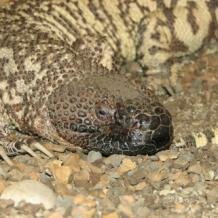 Helodermatids comprise the single genus Heloderma, which evolved from an ancestor (Paraderma) in the Late Cretaceous. The two extant Heloderma species known are Heloderma horridum, the Mexican beaded lizard and Heloderma suspectum, the ‘Glia monster’. Both live in semi-arid environments of America, from southwestern regions of the USA to Mexico and Guatemala. Heloderma possess venom glands in the lower jaw, and their dentary (lower) teeth bear grooves, as in some colubrids, which presumably aid in delivering venom into prey. A dominant groove on the inner tooth surface directs venom to the anterior tooth margin, and a more shallow groove channels it to the posterior margin; both aid in venom delivery as Heloderma tends to chew the flesh of its larger prey (rodents and other small mammals), poisoning and subduing them before they are consumed. Helodermatid venom contains toxins shared with snakes, anguids and varanids, as well as two novel proteins (Extendin and Lethal factor 1) that further enhance the toxicity of Heloderma‘s bite.
Helodermatids comprise the single genus Heloderma, which evolved from an ancestor (Paraderma) in the Late Cretaceous. The two extant Heloderma species known are Heloderma horridum, the Mexican beaded lizard and Heloderma suspectum, the ‘Glia monster’. Both live in semi-arid environments of America, from southwestern regions of the USA to Mexico and Guatemala. Heloderma possess venom glands in the lower jaw, and their dentary (lower) teeth bear grooves, as in some colubrids, which presumably aid in delivering venom into prey. A dominant groove on the inner tooth surface directs venom to the anterior tooth margin, and a more shallow groove channels it to the posterior margin; both aid in venom delivery as Heloderma tends to chew the flesh of its larger prey (rodents and other small mammals), poisoning and subduing them before they are consumed. Helodermatid venom contains toxins shared with snakes, anguids and varanids, as well as two novel proteins (Extendin and Lethal factor 1) that further enhance the toxicity of Heloderma‘s bite.
The early Triassic reptile Uatchitodon kroehleri, discovered in Virginia, is also known for teeth that are remarkably similar to the venom fangs of certain advanced snakes. Uatchitodon is lizard-like but is in fact a member of the ‘archosaurs’, a group of diapsid reptiles evolutionarily distinct from the other major diapsid group (‘lepidosaurs’) to which typical lizards (e.g. Heloderma and Varanus) and snakes belong. As such its venom delivery system is an independent specialization, with parallel features present due to convergence. Uatchitodon teeth are pointed, recurved and blade-like, being compressed transversely and having serrated posterior and apical cutting edges. 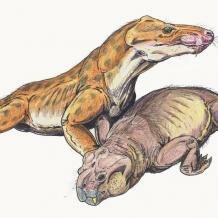 Euchambersia reconstruction” width=”218″ height=”218″>These formidable teeth, clearly adapted for carnivory, also bear deep, almost fully enclosed invaginations, or grooves, on both of the blade surfaces (the outer surface facing the cheek and the inner surface next to the tongue). The grooves are so deep that the internal pulp cavity becomes reduced to small anterior and posterior regions with the central pulp cavity compressed to two very small slits; this is very similar to the situation in elapid and viperid snakes with tubular fangs, where the pulp cavity is compressed into a crescent moon-shape, or ‘lunate’ slit due to deep invagination of the tubule from the anterior tooth surface. By comparison with certain living reptiles, the deeply grooved dentaries of the long-extinct Uatchitodon are inferred to have acted as venom fangs, capable of efficient delivery of toxic venom into prey, and the venom was probably secreted from specialized glands located in the lower jaw.
Euchambersia reconstruction” width=”218″ height=”218″>These formidable teeth, clearly adapted for carnivory, also bear deep, almost fully enclosed invaginations, or grooves, on both of the blade surfaces (the outer surface facing the cheek and the inner surface next to the tongue). The grooves are so deep that the internal pulp cavity becomes reduced to small anterior and posterior regions with the central pulp cavity compressed to two very small slits; this is very similar to the situation in elapid and viperid snakes with tubular fangs, where the pulp cavity is compressed into a crescent moon-shape, or ‘lunate’ slit due to deep invagination of the tubule from the anterior tooth surface. By comparison with certain living reptiles, the deeply grooved dentaries of the long-extinct Uatchitodon are inferred to have acted as venom fangs, capable of efficient delivery of toxic venom into prey, and the venom was probably secreted from specialized glands located in the lower jaw.
Venom fangs in synapsids (mammals and mammal-like reptiles)
The ‘synapsids’ comprise primitively egg-laying animals that are neither true reptiles (e.g. lepidosaurs and archosaurs) nor ‘para-reptiles’ (e.g. mesosaurs, pareiasaurs and turtles). The group Synapsida includes basal taxa such as Dimetrodon as well as a range of more advanced mammal-like reptiles (termed therapsids) and all true mammals, among which we find a few more cases of dentition seemingly adapted for venom delivery. 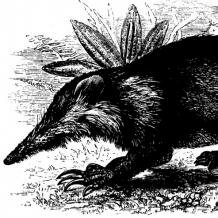 For example, the fossil of a Late Permian therapsid (mammal-like reptile) named Euchambersia has been found in Southern Africa, and bears enlarged canine teeth with a groove running from the base and across the outer, cheek-facing (labial) surface. A venom gland located in a recess from the upper jaw (maxilla) of Euchambersia is presumed to have secreted toxins that were channeled to the base of the canine venom ‘fang’ where grooves in the tooth surface provided a means of precise venom delivery into its prey. Parallels between venomous canine fangs of Euchambersia and the grooved fangs of colubrids such as the hog-nosed snake Heterodon are notable: in spite of vast evolutionary separation they have both converged upon venom glands associated with the upper jaw and enlarged, grooved teeth specialized for venom delivery.
For example, the fossil of a Late Permian therapsid (mammal-like reptile) named Euchambersia has been found in Southern Africa, and bears enlarged canine teeth with a groove running from the base and across the outer, cheek-facing (labial) surface. A venom gland located in a recess from the upper jaw (maxilla) of Euchambersia is presumed to have secreted toxins that were channeled to the base of the canine venom ‘fang’ where grooves in the tooth surface provided a means of precise venom delivery into its prey. Parallels between venomous canine fangs of Euchambersia and the grooved fangs of colubrids such as the hog-nosed snake Heterodon are notable: in spite of vast evolutionary separation they have both converged upon venom glands associated with the upper jaw and enlarged, grooved teeth specialized for venom delivery.
The only true mammals with venomous saliva and associated specialised dentition are four shrew species and the highly endangered solenodons, all of which belong to the large group, or Order, Soricomorpha. 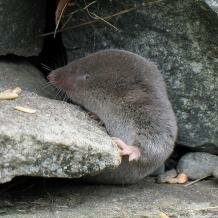 The Eurasian Water shrew Neomys fodiens and three American species of Short-tailed shrew (Blarina brevicauda, B. carolinensis and B. hylophaga) secrete mildly neurotoxic venom from glands in the mouth, and have lightly grooved teeth to assist in delivery of venomous saliva. Neomys and Blarina eat a varied diet of insects, worms and snails as well as preying on larger animals (rodents, birds and snakes), at which point their ability to deliver toxic, immobilizing venom becomes critical. The shrew-like genus Solenodon consists of two extinct and two endangered species, the Cuban solenodon S. cubanus and the Hispaniolan solendon S. paradoxus. Modified salivary glands in the mandible (lower jaw) secrete venomous saliva which is channeled through specialized grooves within the second pair of lower incisors. This pair of grooved incisors is used in venom delivery and explains the name ‘solenodon’, which is derived from the Greek for ‘grooved tooth’. The venom channels of shrew teeth and the Solendon second incisor are reminiscent of the grooved canines of Euchambersia, although solenodont venom glands and fangs are located in the lower, rather than the upper jaw.
The Eurasian Water shrew Neomys fodiens and three American species of Short-tailed shrew (Blarina brevicauda, B. carolinensis and B. hylophaga) secrete mildly neurotoxic venom from glands in the mouth, and have lightly grooved teeth to assist in delivery of venomous saliva. Neomys and Blarina eat a varied diet of insects, worms and snails as well as preying on larger animals (rodents, birds and snakes), at which point their ability to deliver toxic, immobilizing venom becomes critical. The shrew-like genus Solenodon consists of two extinct and two endangered species, the Cuban solenodon S. cubanus and the Hispaniolan solendon S. paradoxus. Modified salivary glands in the mandible (lower jaw) secrete venomous saliva which is channeled through specialized grooves within the second pair of lower incisors. This pair of grooved incisors is used in venom delivery and explains the name ‘solenodon’, which is derived from the Greek for ‘grooved tooth’. The venom channels of shrew teeth and the Solendon second incisor are reminiscent of the grooved canines of Euchambersia, although solenodont venom glands and fangs are located in the lower, rather than the upper jaw.
Convergent evolution of venom and fangs
The above account of venom and fangs in snakes, anguiform lizards, the archosaur Uatchitodon, therapsid Euchambersia and mammals Solendon, Neomys and Blarina, provides a remarkable case study in convergent evolution. The therapsid Euchambersia appears to have converged most closely with caenophidian snake fangs in having specialized grooved canine ‘fangs’ for delivery of venom secreted from glands in the upper jaw. The lizard Heloderma, shrews Neomys and Blarina, and Solenodon have converged upon colubrid snake-type dentition in possessing grooved fangs, which in Solenodon are even restricted to one specialized pair of teeth (the second lower incisors); this, in spite of the extreme evolutionary separation between the taxa in question. Furthermore, the archosaur Uatchitodon possessed dentary fangs with deep, almost enclosed grooves that very closely resemble the hollow fangs of vipers and elapids. These cases thus represent excellent instances of convergent evolution between snakes and more disparate reptiles (e.g. Heloderma, Uatchitodon), and even non-reptiles (e.g. Euchambersia, Solenodon, Neomys, Blarina), all bearing forms of dentition adapted for venom delivery.
With respect to the independent evolution of toxic venom itself, the convergence between venomous reptiles (e.g. snakes + lizards, Uatchitodon), mammal-like reptiles (e.g. Euchambersia) and mammals (e.g. Solenodon, Neomys, Blarina) is also striking. Even so, we can move beyond these vertebrates to many well-known examples of toxic invertebrates, including certain arthropods, notably scorpions and hymenopterans (e.g. bees and wasps), and also molluscs (notoriously cone shells) and certain polychaete annelids.
Cite this web page
Map of Life - "Venom and venom fangs in snakes, lizards and synapsids"
https://mapoflife.org/topics/topic_388_venom-and-venom-fangs-in-snakes-lizards-and-synapsids/
March 3, 2021

